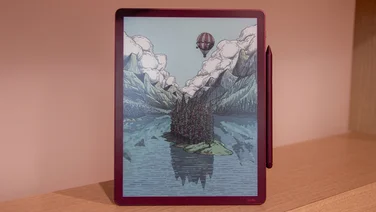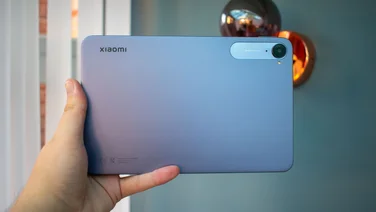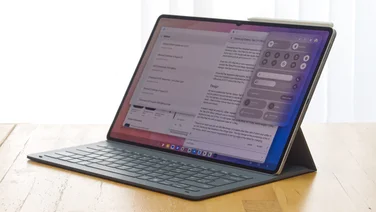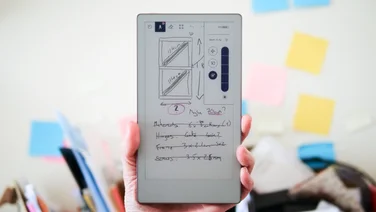To help us provide you with free impartial advice, we may earn a commission if you buy through links on our site. Learn more

With a distinctive bulging base and integrated kick stand, Lenovo’s Yoga Tab range has always been distinctive, and the third iteration is no different. The large cylindrical base gives you something to grip when holding the tablet in one hand, makes room for a larger capacity battery and makes room for the unique hinged stand that can prop the screen up for hands-free use. It’s sturdy enough that you can tap the screen without sending it tumbling over. There’s even a hole that you can hang the tablet from, making it ideal for reading recipes in the kitchen.
Lenovo has improved the formula this year by integrating the camera into the base. Instead of one camera sensor on the front for video calling and a second on the back for taking photos, you get a single module, mounted on a 180-degree rotating hinge so it can be pointed in either direction. With the tablet held horizontally, the camera app automatically re-orients the live view when you rotate it from front to back, so all your photos will be the right way up. Admittedly the angle isn’t particularly flattering when the tablet is in Stand mode, but the 8-megapixel sensor is a big improvement over typical front-facing tablet cameras, so image quality is much better.

In fact, picture sharpness and level of detail are both very impressive for a budget tablet, with outdoor images showing all the textures you would expect from brick, tile and concrete surfaces. It somehow managed to blow out the sky and white painted brickwork, however, despite it being a particularly cloudy day and it not being especially bright.
HDR images take well over three seconds to capture, making camera shake a real issue. While the effect managed to restore some of the detail in the overcast sky, it oversaturated the brickwork of nearby buildings. The resulting image didn’t look natural at all.

^ The 100% crop shows a surprising amount of detail, but colours are way off in this HDR shot
Moving indoors reveals the need for lots of light to get noise-free images. Unless it was well-lit, all my test shots looked grainy and lacked fine detail. Colours were at least more accurate, but the results weren’t exactly fantastic. The camera also struggled to focus, despite indicating it had done so onscreen, leaving test images looking blurry. It will do in a pinch, but the Yoga Tab 3 won’t replace your smartphone camera.
Photos and videos looked bright and colourful enough on the 8in display, although objective tests reveal that Lenovo has used a fairly average quality panel. With 78.2% sRGB colour gamut coverage and a 700:1 contrast ratio, colours weren’t as accurate as more expensive tablets like the iPad Mini or as vibrant as the AMOLED panel on Samsung’s Galaxy Tab S2. They were only slightly behind Tesco’s excellent-value Hudl 2, however, and are better overall than EE’s more expensive Eagle tablet.
A maximum brightness of 368.2cd/m2 is fairly average for an 8in tablet, and is high enough to use comfortably indoors or outside. While viewing angles are very good, the glossy screen finish could make light reflections an issue. Black levels were also disappointingly high at 0.53cd/m2, leaving dark images looking slightly greyer than I would like. You don’t have to get close to the screen to spot individual pixels, with the 1,280×800 resolution only equating to a pixel density of 189ppi. It can make small text look very blocky and difficult to read.

The lower screen resolution also helps when it comes to performance, as the processor and GPU aren’t working as hard as they otherwise would be on a Full HD tablet. The quad-core, 1.3GHz Qualcomm Snapdragon 212 isn’t exactly a powerful chip, especially when paired with just 1GB of RAM. It still manages to open apps fairly quickly, but there’s the slightest hint of lag with every tap. With mediocre scores of 315 and 1105 in the Geekbench 3 single- and multi-threaded benchmarks respectively, the Yoga Tab 3 is slower than virtually every 8in tablet we’ve reviewed this year, so is definitely more suited to single light-use tasks rather than more demanding apps.
It was a similar story when web browsing, with a Peacekeeper browser benchmark score of 524 putting it below average and media-heavy websites forced to redraw a lot more often than on other, more powerful tablets.
The Adreno 304 GPU is moderately capable, playing 3D games smoothly and playing back HD video clips without any issue, but scores of 244.1 (4fps) and 113.5 (2fps) in the GFX Bench 3 Manhattan onscreen and offscreen tests are disappointingly low. The Tab didn’t meet the minimum specifications for Blizzard’s Hearthstone, and while you can ignore the warning and play regardless, animations can stutter and the game takes quite a while to load.
The Yoga Tab 3 does excel in some areas, however. The chunky cylindrical base has room inside for a much bigger battery than you’d typically find in an 8in tablet. The 6,200mAh cell will easily last all day on a full charge, as it managed a superb 14 hours 49 minutes in the Expert Reviews video rundown test. That’s on par with several tablets that cost twice the price, including the Samsung Galaxy Tab S2 and Dell Venue 8. Unlike other Android tablets, it doesn’t drain very quickly in standby mode, either – meaning it will still have charge if you leave it in a drawer for a few days.

^ Multiple hinge positions are great for using the Yoga Tab on your lap, or at a desk
Lenovo’s custom Android skin doesn’t place too much added strain on the hardware, either. It’s deceptively minimal, taking the best parts of Android 5.1 Lollipop and adding some extra customisation. Being able to adjust the size of the home screen grid and hide app labels without having to download a custom launcher is a welcome extra touch, especially when the home screen, app drawer and notification tray all use the default Material UI layout. Even the app icons manage to fit in with the stock Android ones, although some (like the Music app) feel incredibly outdated compared to Google’s own.
There aren’t too many pre-installed apps to worry about, either, with a custom synchronisation tool for backup up phonebook contacts and files, and a transfer app for sharing documents with other users. They aren’t must-haves, by any means, but you can thankfully disable or uninstall them if you don’t want them cluttering up your app drawer.
The biggest addition is the Dolby sound app, which adds an audio equaliser with separate modes for films, games, music and voice. It can’t recognise content, so you have to change them manually, but they can give electronic and rock tracks a welcome boost to the bass and top-end with just a few presses. Virtual surround isn’t entirely convincing in films or games, but it does extend the soundstage and does a great job with music too, bringing vocals to the centre of the mix. It does increase the overall volume of the mix, however, so the Volume Leveller toggle can help avoid accidental eardrum blowouts by averaging everything to the system volume.
Sound quality in general was very good, especially for a budget tablet, with the two front-facing speakers delivering loud audio that can easily be heard from across a room. Trebles sound clear and there’s even some resemblance of bass, although it does somewhat muddy the mid-range when you crank up the volume. Keep it to below 75% and it’s perfectly suited to watching YouTube videos or streaming NetFlix without reaching for a pair of headphones.

^ The hinge releases with a button press and feels very sturdy
The speaker grilles mesh neatly into the cylindrical base and avoid spoiling the slick overall look. Unsurprisingly for a budget tablet there’s a lot of plastic in use, but the soft-touch finish on the back creates plenty of grip. When holding the Tab one-handed, you naturally rest on the metal stand, anyway, so it actually feels more like a premium device.
The bulge at the bottom notwithstanding, the rest of the tablet is only 7mm thick, and at 420g its light enough to hold comfortably in one hand. There’s admittedly not a lot of room around the edges for ports, with just a 3.5mm audio jack and a microUSB port. Lenovo has managed to fit a microSD card reader underneath the kickstand. It’s compatible with 128GB cards, which is useful considering the 16GB base model only has 11GB of user-accessible storage.
Conclusion
With a functional design, high quality speakers and a decent (though not class-leading) screen, the Yoga Tab 3 is a great budget tablet. It might not have the sleek looks of the Asus ZenPad S, but the unique appearance makes it much more flexible, coming in handy when you want to watch videos or play games hands-free. Anyone after performance would be better served by Nvidia’s Shield Tablet, but for video and web browsing this it’s an ideal multi-purpose tablet.






